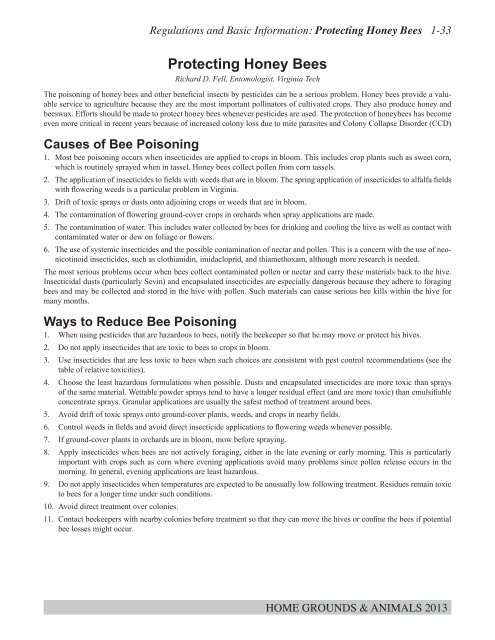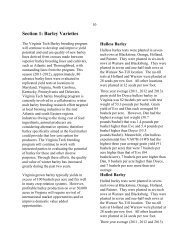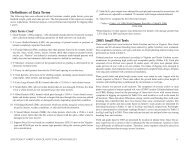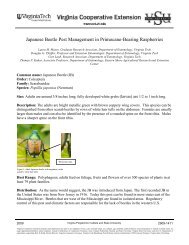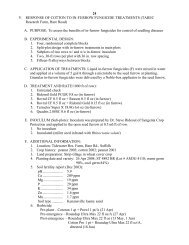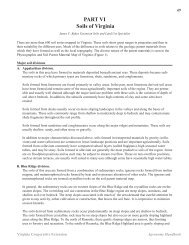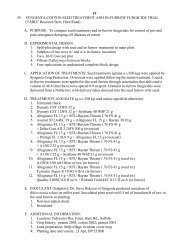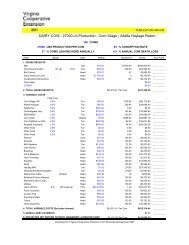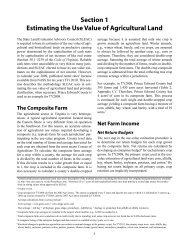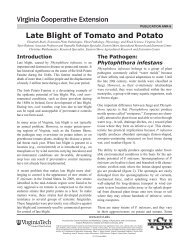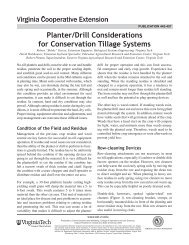Protecting Honey Bees 33-36 - Virginia Tech
Protecting Honey Bees 33-36 - Virginia Tech
Protecting Honey Bees 33-36 - Virginia Tech
Create successful ePaper yourself
Turn your PDF publications into a flip-book with our unique Google optimized e-Paper software.
Regulations and Basic Information: <strong>Protecting</strong> <strong>Honey</strong> <strong>Bees</strong> 1-<strong>33</strong><br />
<strong>Protecting</strong> <strong>Honey</strong> <strong>Bees</strong><br />
Richard D. Fell, Entomologist, <strong>Virginia</strong> <strong>Tech</strong><br />
The poisoning of honey bees and other beneficial insects by pesticides can be a serious problem. <strong>Honey</strong> bees provide a valuable<br />
service to agriculture because they are the most important pollinators of cultivated crops. They also produce honey and<br />
beeswax. Efforts should be made to protect honey bees whenever pesticides are used. The protection of honeybees has become<br />
even more critical in recent years because of increased colony loss due to mite parasites and Colony Collapse Disorder (CCD)<br />
Causes of Bee Poisoning<br />
1. Most bee poisoning occurs when insecticides are applied to crops in bloom. This includes crop plants such as sweet corn,<br />
which is routinely sprayed when in tassel. <strong>Honey</strong> bees collect pollen from corn tassels.<br />
2. The application of insecticides to fields with weeds that are in bloom. The spring application of insecticides to alfalfa fields<br />
with flowering weeds is a particular problem in <strong>Virginia</strong>.<br />
3. Drift of toxic sprays or dusts onto adjoining crops or weeds that are in bloom.<br />
4. The contamination of flowering ground-cover crops in orchards when spray applications are made.<br />
5. The contamination of water. This includes water collected by bees for drinking and cooling the hive as well as contact with<br />
contaminated water or dew on foliage or flowers.<br />
6. The use of systemic insecticides and the possible contamination of nectar and pollen. This is a concern with the use of neonicotinoid<br />
insecticides, such as clothianidin, imidacloprid, and thiamethoxam, although more research is needed.<br />
The most serious problems occur when bees collect contaminated pollen or nectar and carry these materials back to the hive.<br />
Insecticidal dusts (particularly Sevin) and encapsulated insecticides are especially dangerous because they adhere to foraging<br />
bees and may be collected and stored in the hive with pollen. Such materials can cause serious bee kills within the hive for<br />
many months.<br />
Ways to Reduce Bee Poisoning<br />
1. When using pesticides that are hazardous to bees, notify the beekeeper so that he may move or protect his hives.<br />
2. Do not apply insecticides that are toxic to bees to crops in bloom.<br />
3. Use insecticides that are less toxic to bees when such choices are consistent with pest control recommendations (see the<br />
table of relative toxicities).<br />
4. Choose the least hazardous formulations when possible. Dusts and encapsulated insecticides are more toxic than sprays<br />
of the same material. Wettable powder sprays tend to have a longer residual effect (and are more toxic) than emulsifiable<br />
concentrate sprays. Granular applications are usually the safest method of treatment around bees.<br />
5. Avoid drift of toxic sprays onto ground-cover plants, weeds, and crops in nearby fields.<br />
6. Control weeds in fields and avoid direct insecticide applications to flowering weeds whenever possible.<br />
7. If ground-cover plants in orchards are in bloom, mow before spraying.<br />
8. Apply insecticides when bees are not actively foraging, either in the late evening or early morning. This is particularly<br />
important with crops such as corn where evening applications avoid many problems since pollen release occurs in the<br />
morning. In general, evening applications are least hazardous.<br />
9. Do not apply insecticides when temperatures are expected to be unusually low following treatment. Residues remain toxic<br />
to bees for a longer time under such conditions.<br />
10. Avoid direct treatment over colonies.<br />
11. Contact beekeepers with nearby colonies before treatment so that they can move the hives or confine the bees if potential<br />
bee losses might occur.<br />
HOME GROUNDS & ANIMALS 2013
1-34 Regulations and Basic Information: <strong>Protecting</strong> <strong>Honey</strong> <strong>Bees</strong><br />
Relative Toxicity of Pesticides to<br />
<strong>Honey</strong> <strong>Bees</strong> by Laboratory and Field Tests<br />
Group I. Highly Toxic<br />
Severe losses may be expected if these pesticides are used when bees are present at treatment time or within a day thereafter.<br />
Abamectin<br />
Acramite<br />
(bifenazate)<br />
Actara, Centric,<br />
Platinum, Helix,<br />
Cruiser, Adage<br />
(thiamethoxam)<br />
Address<br />
(acephate)<br />
Admire<br />
(imidacloprid)<br />
Advantage<br />
Afugan<br />
(pyrazophos)<br />
Ambush<br />
(permethrin)<br />
Ammo (Fury)<br />
(>.025 lb/acre)<br />
(cypermethrin)<br />
Apollo<br />
(clofentezine)<br />
Arsenicals<br />
Asana<br />
(esfenvalerate)<br />
Avaunt (Advion)<br />
(indoxacarb)<br />
Avid<br />
(avermectin)<br />
Azodrin<br />
(monocrotophos)<br />
Baygon<br />
(propoxur)<br />
Baytex<br />
(fenthion)<br />
Baythroid<br />
(cyfluthrin)<br />
BHC<br />
Bidrin<br />
(dicrotophos)<br />
Bux<br />
(bufencarb)<br />
Capture, Annex,<br />
Brigade<br />
(bifenthrin)<br />
Carzol<br />
Cidial<br />
(phenthoate)<br />
Clutch<br />
(clothianidin)<br />
Commodore<br />
(lambda-cyhalothrin)<br />
Comply<br />
(fenoxycarb)<br />
Curacron<br />
(profenofos)<br />
Cygon<br />
(dimethoate)<br />
Cymbush<br />
Cythion<br />
(malathion)<br />
Danitol<br />
(fenopropathin)<br />
Dasanit<br />
(fensulfothion)<br />
DDVP<br />
(dichlorvos)<br />
Decis<br />
(decamethrin)<br />
Delegate, Radiant<br />
(spinetoram)<br />
Denim<br />
(emamectin<br />
benzoate)<br />
Dibrom<br />
(naled)<br />
De-fend, Dimate<br />
(dimethoate)<br />
Diazinon<br />
(spectracide)<br />
Dimecron<br />
(phosphamidon)<br />
Dursban, Eradex<br />
(chlorpyrifos)<br />
Ectrin<br />
(fenvalerate)<br />
Ekamet<br />
(etrimphos)<br />
Endigo<br />
Envidor<br />
(spirodiclofen)<br />
EPN<br />
Ethyl guthion<br />
(azinphos-ethyl)<br />
Famphos<br />
(famphur)<br />
Ficam<br />
(bendiocarb)<br />
Folimat<br />
Fipronil<br />
HOME GROUNDS & ANIMALS 2013<br />
Furadan F<br />
(carbofuran)<br />
Fury<br />
(zeta-cypermethrin)<br />
Gardona<br />
(tetrachlorvinphos)<br />
Guard Star<br />
(permethrin) 1<br />
Guthion<br />
(azinphos-methyl)<br />
Imidan<br />
(phosmet)<br />
Karate<br />
Lannate D<br />
(methomyl)<br />
Lindane<br />
Lorsban<br />
(chlorphyrifos)<br />
Malathion<br />
(Malathion G)<br />
Matacil<br />
(aminocarb)<br />
Mesurol<br />
(methiocarb)<br />
Methyl parathion<br />
Monitor<br />
(methamidophos)<br />
Nemacur P<br />
(phenamiphos)<br />
Nexter<br />
(pyridaben)<br />
Nudrin<br />
(methomyl)<br />
1 Can be applied to ground in front of beehives for the control of small hive beetles.<br />
2 Can be applied in the late evening at rate of 0.1 lb/A or less.<br />
3 Some formulations of Sevin XLR are rated as moderately toxic.<br />
Orthene<br />
(acephate)<br />
Pact<br />
(thianitrile)<br />
Parathion<br />
Pay Off<br />
(flucythrinate)<br />
Phosdrin<br />
(mevinphos)<br />
Phosphamidon<br />
Poncho,<br />
Titan, Clutch<br />
(clothianidin)<br />
Pounce<br />
(permethrin)<br />
Proaxis<br />
(gamma-cyhalothrin)<br />
Proclaim<br />
(emamectin)<br />
Provado<br />
(imidacloprid)<br />
Pydrin<br />
(fenvalerate 0.1<br />
lb/A) 2<br />
Pyramite<br />
Rebelate<br />
(dimethoate)<br />
Resmethrin<br />
Scout<br />
(tralomethrin)<br />
Sevin<br />
(carbaryl) 3<br />
Spectracide<br />
Steward<br />
(indoxacarb)<br />
Sumithion<br />
(fenitrothion)<br />
Supracide<br />
(methidathion)<br />
Swat<br />
(bonyl)<br />
Synthrin<br />
(resmethrin)<br />
Talstar<br />
Tameron<br />
(methamidophos)<br />
Temik<br />
(aldicarb)<br />
TEPP<br />
Trimax<br />
Vapona<br />
(dichlorvos)<br />
Venom<br />
(dinotefuran)<br />
Warrior<br />
(lambda-cyhalothrin)<br />
Zectran<br />
(mexacarbate)<br />
Zephyr (Agri-Mek)<br />
(abamectin)
Regulations and Basic Information: <strong>Protecting</strong> <strong>Honey</strong> <strong>Bees</strong> 1-35<br />
Group II. Moderately Toxic<br />
These can be used around bees if dosage, timing, and method of application are correct, but should not be applied directly on<br />
bees in the field or at the colonies.<br />
Abate<br />
(temophos)<br />
Acramite<br />
(bifenazate)<br />
Agritox<br />
(trichloronate)<br />
Assail<br />
(acetamiprid)<br />
Banol<br />
(carbanolate)<br />
Bolstar<br />
(sulprofos)<br />
Calypso<br />
(thiacloprid)<br />
Carzol<br />
(formetanate)<br />
Chlordane<br />
Ciodrin<br />
(crotoxyphos)<br />
Coumaphos 1<br />
(Agridip, Asunthol)<br />
Counter<br />
(terbufos)<br />
Croneton<br />
(ethiofencarb)<br />
Decis, Battalion<br />
(deltamethrin)<br />
Di-Syston<br />
(disulfoton)<br />
Dyfonate<br />
(fonofos)<br />
Elgetol<br />
(dinitrocresol)<br />
endrin<br />
Esteem<br />
(pyriproxyfen)<br />
Ethodan<br />
(Ethion)<br />
Korlan<br />
(ronnel)<br />
Larvin<br />
(thiocarb)<br />
Metasystox<br />
(demeton-smethyl)<br />
Metasystox R<br />
(oxydemetonmethyl)<br />
Mocap<br />
(ethoprop)<br />
Oil sprays<br />
(superior type)<br />
Perthane<br />
(ethylan)<br />
Pirimor<br />
(pirimicarb)<br />
Pyramat<br />
Rhonthane (RDE)<br />
SpinTor<br />
(Conserve SC)<br />
(Entrust)<br />
(spinosad)<br />
1 Checkmite (coumaphos) strip can be used in beehives to treat for varroa mites and small hive beetles.<br />
2 Thimet EC should only be applied during late evening.<br />
Group III. Relatively Nontoxic<br />
These can be used around bees with a minimum of injury<br />
Acaraben<br />
(chlorobenzilate)<br />
Acarol<br />
(bromopropylate)<br />
Agri-Mek<br />
(avermectin)<br />
Allethrin<br />
Altosid<br />
(methoprene)<br />
Amitraz<br />
Apollo<br />
(clofentezine)<br />
Applaud, Centaur<br />
(buprofezin)<br />
Aza-direct<br />
(azadirachtin)<br />
Baam<br />
(amitraz)<br />
Bacillus<br />
thuringiensis<br />
(Accoate, Biotrol,<br />
Dipel, Thuricide)<br />
Birlane<br />
(chlorfenvinphos)<br />
Calypso<br />
(thiacloprid)<br />
Chlorantraniliprole<br />
Chloroparacide<br />
(chlorbenside)<br />
Confirm<br />
(tebufenozide)<br />
Cyd-X<br />
(CM granulovirus)<br />
cyrolite<br />
Dasanit G<br />
(fensulfothion)<br />
Delnav<br />
(dioxathion)<br />
Demize<br />
(D-Limonene)<br />
Dessin<br />
(dinobuton)<br />
Dimilin<br />
(diflubenzuron)<br />
Dinocap<br />
(Karathane)<br />
Dylox<br />
(trichlorfon)<br />
Ethrel<br />
(ethephon)<br />
Esteem<br />
(pyriproxyfen)<br />
Fujimite<br />
(fenpyroximate)<br />
Fulfill<br />
(pymetrozine)<br />
Fundal,<br />
Galecron<br />
(chlordimeform)<br />
Heliothis polyhedrosis<br />
virus<br />
Intrepid<br />
(methoxyfenozide)<br />
Isomate<br />
Kanemite<br />
(acequinocyl)<br />
Kelthane<br />
(dicofol)<br />
Mavrik<br />
(fluvalinate) 1<br />
methoxychlor<br />
(Marlate)<br />
Mitac<br />
(amitraz)<br />
Morestan<br />
(oxythioquinox)<br />
Morocide<br />
(binapacryl)<br />
Murvesco<br />
(fenson)<br />
Neemix (Align)<br />
(azidirachtin)<br />
Neotran<br />
nicotine<br />
Omite<br />
(propargite)<br />
Ovotran<br />
(ovex)<br />
Pentac<br />
(dienochlor)<br />
Plictran [mitacid]<br />
(cyhexatin)<br />
Pynamin<br />
Pyrellin<br />
(rotenone/<br />
pyrithrin)<br />
pyrethrum<br />
(natural)<br />
rotenone<br />
ryania<br />
Rynaxypyr<br />
(chlorantraniliprole)<br />
sabadilla<br />
Saphos<br />
(menazon)<br />
Savey<br />
(hexythiazox)<br />
1 Fluvalinate is used in Apistan strips to treat beehives for varroa mites. It is illegal to use Mavrik in hives.<br />
Systox (demeton)<br />
Trigard<br />
(cyromazine)<br />
Thimet<br />
(phorate) 2<br />
Thionex<br />
(endosulfan)<br />
Trithion<br />
(carbophenothion)<br />
Vydate<br />
(oxamyl)<br />
Smite<br />
(sodium azide)<br />
Spur<br />
(fluvalinale)<br />
Surround<br />
(kaolin)<br />
Tedion<br />
(tetradifon)<br />
tetram<br />
Tokuthion<br />
(prothiophos)<br />
Torak<br />
(dialifor)<br />
Trigard<br />
(cyromazine)<br />
Vendex<br />
(fenbutatin oxide)<br />
Zeal<br />
(etoxazole)<br />
HOME GROUNDS & ANIMALS 2013
1-<strong>36</strong> Regulations and Basic Information: <strong>Protecting</strong> <strong>Honey</strong> <strong>Bees</strong><br />
Fungicides<br />
As a general rule, fungicides are safe to use around honey bees.<br />
Afugan<br />
(pyrazophos)<br />
Arasan<br />
(thiram)<br />
Bayleton<br />
(triadimefon)<br />
Benlate<br />
(benomyl)<br />
bordeaux mixture<br />
Bravo<br />
(chlorothalonil)<br />
Captan<br />
copper oxides<br />
copper oxychloride<br />
sulfate<br />
copper sulfate<br />
cupric hydroxide<br />
(Kocide)<br />
Cyprix<br />
(dodine)<br />
Daconil<br />
(chlorothalonil)<br />
Dessin<br />
(dinobuton)<br />
Difolatan<br />
(captafol)<br />
Dithane D-14<br />
(nabam)<br />
Dithane M<br />
(maneb, manzeb)<br />
Dithane Z<br />
(zineb)<br />
Du-Ter<br />
(fentin hydroxide)<br />
Dyrene<br />
(anilazine)<br />
ferbam<br />
Glyodin<br />
HOME GROUNDS & ANIMALS 2013<br />
Hinosan<br />
(edifenphos)<br />
Indar<br />
(butrizol)<br />
Karathane<br />
Lesan<br />
(fenaminosulf)<br />
Maneb<br />
Mancozeb<br />
Morestan<br />
(oxythioquinox)<br />
Morocide<br />
(binapaeryl)<br />
1 May increase the toxicity of neonicatinoid insecticides to honeybees if used together.<br />
2 May cause loss of honeybee larvae. Use with caution where bees are foraging.<br />
Herbicides, Defoliants and Dessicants<br />
2,4-D<br />
2,4-DB<br />
2,4-DP<br />
(dichlorprop)<br />
Alachlor<br />
Alanap<br />
(naptalam)<br />
Alopex<br />
(clofop-isobutyl)<br />
Amiben<br />
(chloramben)<br />
Amitrol<br />
Ammate<br />
Atrex<br />
(atrazine)<br />
Avenge<br />
(difenzoquat)<br />
Balan<br />
(benefin)<br />
Banvel<br />
(dicamba)<br />
Basagran<br />
(bentazon)<br />
Betanal AM<br />
(bentanex)<br />
Bladex<br />
(cyanazine)<br />
Blazer<br />
(acifluorfen)<br />
cacodylic acid<br />
Cambilene<br />
(2,3,6-TBA)<br />
Caparol<br />
(prometryn)<br />
Chloro-IPC<br />
(chlorpropham)<br />
Cotoran<br />
(fluometuron)<br />
Daconate<br />
(MSMA)<br />
dalapon<br />
diquat<br />
DSMA<br />
Dual<br />
(metolachlor)<br />
Endothall<br />
(endothall)<br />
Eptam<br />
Evik<br />
(ametryn)<br />
Evital<br />
(norflurazon)<br />
Exhalt 800<br />
Folex<br />
(desmedipham)<br />
Garlon<br />
(triclopyr)<br />
Glyphosate<br />
Gramoxone<br />
(paraquat)<br />
Herbisan<br />
(EXD)<br />
Hoelon<br />
(diclofop-methyl)<br />
Hyvar<br />
(bromacil)<br />
IPC<br />
(propham)<br />
Karmex<br />
(diuron)<br />
Kerb<br />
(proamide)<br />
Lasso<br />
(alachlor)<br />
Lorox<br />
(linuron)<br />
MCPA<br />
Methar,<br />
DSMA<br />
Milogard<br />
(propazine)<br />
Modown<br />
(bitenox)<br />
MSMA<br />
Mylone<br />
(dazomet)<br />
Phygon<br />
(dichlone)<br />
Plantvax<br />
(oxycarboxin)<br />
Polyram<br />
(metriam)<br />
Ridomil<br />
Rovral<br />
(iprodione) 2<br />
sulfur<br />
Mylone<br />
(dazomet)<br />
Nortron<br />
(ethofumesate)<br />
Paarlan<br />
(isopropalin)<br />
paraquat<br />
Pendimethalin<br />
(Prowl)<br />
Phenmedipham<br />
(Betanal)<br />
Pramitol<br />
(prometone)<br />
Princep<br />
(simazine)<br />
Probe<br />
(methazole)<br />
Prowl<br />
(pendimethalin)<br />
Ramrod<br />
(propachlor)<br />
Randox<br />
Syllit<br />
(dodine)<br />
Terraguard 1 ,<br />
Procure<br />
(triflumizole)<br />
Thiram<br />
Thylate<br />
Vitavax<br />
(carboxin)<br />
Zerlate<br />
(Ziram)<br />
Zineb<br />
Ronstar<br />
(oxadiazon)<br />
Sancap<br />
(dipropetryn)<br />
Sencor<br />
(metribuzin)<br />
Sinbar<br />
(terbacil)<br />
Surflan<br />
(oryzalin)<br />
Sutan<br />
(butylate)<br />
Telvar<br />
(monuran)<br />
Tolban<br />
(profluralin)<br />
Tordon<br />
(picloram)<br />
Treflan<br />
(trifluralin)<br />
Vegadex<br />
Zorial<br />
(norflurazon)


